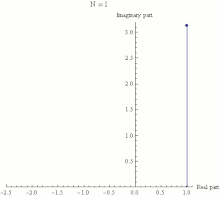Euler's identity: Difference between revisions
Mindmatrix (talk | contribs) m Reverted edits by 108.58.38.194 (talk) to last version by Drf5n |
→External links: Added a page that demonstrates Euler's function with intuitive clarity, rather than mathematical rigor. Helpful to those who struggle with advanced math proofs. |
||
| Line 94: | Line 94: | ||
==External links== |
==External links== |
||
* [http://www.youtube.com/watch?v=UcGDNUDQCc4 Complete derivation of Euler's identity] |
* [http://www.youtube.com/watch?v=UcGDNUDQCc4 Complete derivation of Euler's identity] |
||
* [http:///betterexplained.com/articles/intuitive-understanding-of-eulers-formula/ Intuitive understanding of Euler's formula] |
|||
{{DEFAULTSORT:Euler's Identity}} |
{{DEFAULTSORT:Euler's Identity}} |
||
[[Category:Complex analysis]] |
[[Category:Complex analysis]] |
||
Revision as of 21:31, 8 October 2011

| Part of a series of articles on the |
| mathematical constant e |
|---|
 |
| Properties |
| Applications |
| Defining e |
| People |
| Related topics |
In analytical mathematics, Euler's Identity, named for the Swiss-German mathematician Leonhard Euler, is the equality
where
- e is Euler's number, the base of natural logarithms,
- i is the imaginary unit, which satisfies i2 = −1, and
- π is pi, the ratio of the circumference of a circle to its diameter.
Euler's Identity is also sometimes called Euler's Equation.
Mathematical beauty
Euler's identity is considered by many to be remarkable for its mathematical beauty. These three basic arithmetic operations occur exactly once each: addition, multiplication, and exponentiation. The identity also links five fundamental mathematical constants:
- The number 0, the additive identity.
- The number 1, the multiplicative identity.
- The number π, which is ubiquitous in trigonometry, the geometry of Euclidean space, and analytical mathematics (π = 3.14159265...)
- The number e, the base of natural logarithms, which occurs widely in mathematical and scientific analysis (e = 2.718281828...). Both π and e are transcendental numbers.
- The number i, the imaginary unit of the complex numbers, a field of numbers that contains the roots of all polynomials (that are not constants), and whose study leads to deeper insights into many areas of algebra and calculus, such as integration in calculus.
Furthermore, in algebra and other areas of mathematics, equations are commonly written with zero on one side of the equals sign.
A poll of readers conducted by The Mathematical Intelligencer magazine named Euler's Identity as the "most beautiful theorem in mathematics".[1] Another poll of readers that was conducted by Physics World magazine, in 2004, chose Euler's Identity tied with Maxwell's equations (of electromagnetism) as the "greatest equation ever".[2]
An entire 400-page mathematics book, Dr. Euler's Fabulous Formula (published in 2006), written by Dr. Paul Nahin (a Professor Emeritus at the University of New Hampshire), is devoted to Euler's Identity. This monograph states that Euler's Identity sets "the gold standard for mathematical beauty."[3]
Constance Reid claimed that Euler's Identity was "the most famous formula in all mathematics."[4]
The mathematician Carl Friedrich Gauss was reported to have commented that if this formula was not immediately apparent to a student upon being told it, that student would never become a first-class mathematician.[5]
After proving Euler's Identity during a lecture, Benjamin Peirce, a noted American 19th century philosopher/mathematician and a professor at Harvard University, stated that "It is absolutely paradoxical; we cannot understand it, and we don't know what it means, but we have proved it, and therefore we know it must be the truth."[6]
Stanford University mathematics professor Dr. Keith Devlin said, "Like a Shakespearean sonnet that captures the very essence of love, or a painting that brings out the beauty of the human form that is far more than just skin deep, Euler's Equation reaches down into the very depths of existence."[7]
Explanation

The identity is a special case of Euler's formula from complex analysis, which states that
for any real number x. (Note that the arguments to the trigonometric functions sine and cosine are taken to be in radians, and not in degrees.) In particular, with , or one half turn around the circle:
Since
and
it follows that
which gives the identity
Generalizations
Euler's Identity is actually a special case of the more general identity that the nth roots of unity, for n > 1, add up to 0:
Euler's identity is the case where n = 2.
In another field of mathematics, by using quaternion exponentiation, one can show that a similar identity also applies to quaternions:
Attribution
While Euler wrote about his formula that relates e with cosine and sine terms, in the field of complex numbers, there is no known record of Euler's actually stating or deriving the simplified identity equation itself. Furthermore, Euler's formula was probably known before the life of Euler.[8] (If so, then this usage would be an example of Stigler's law of eponymy.) Thus, the question of whether or not this identity should be attributed to Euler is unanswerable.
See also
Notes
References
- Crease, Robert P., "The greatest equations ever", PhysicsWeb, October 2004 (registration required).
- Crease, Robert P. "Equations as icons," PhysicsWeb, March 2007 (registration required).
- Derbyshire, J. Prime Obsession: Bernhard Riemann and the Greatest Unsolved Problem in Mathematics (New York: Penguin, 2004).
- Kasner, E., and Newman, J., Mathematics and the Imagination (Simon & Schuster, 1940).
- Maor, Eli, e: The Story of a number (Princeton University Press, 1998). ISBN 0-691-05854-7
- Nahin, Paul J., Dr. Euler's Fabulous Formula: Cures Many Mathematical Ills (Princeton University Press, 2006). ISBN 978-0691118222
- Reid, Constance, From Zero to Infinity (Mathematical Association of America, various editions).
- Sandifer, Ed, "Euler's Greatest Hits", MAA Online, February 2007.










